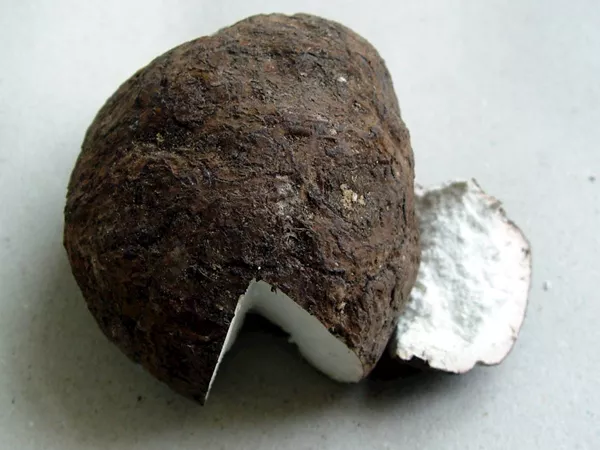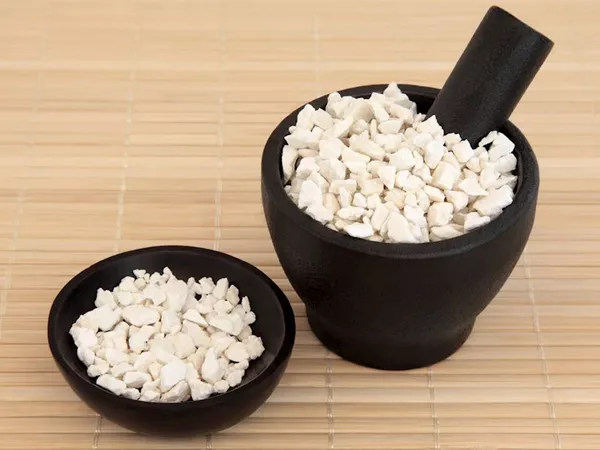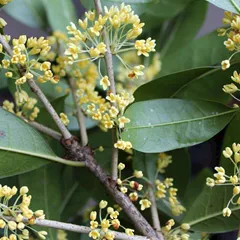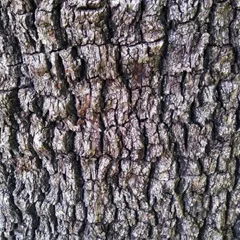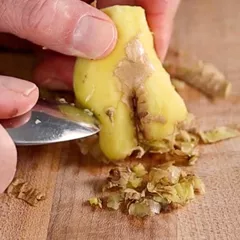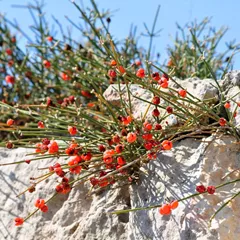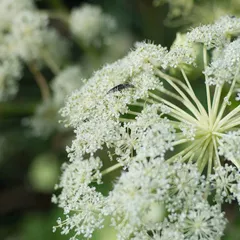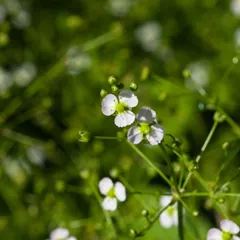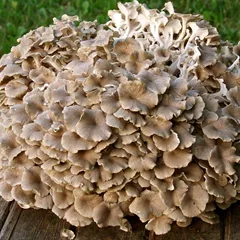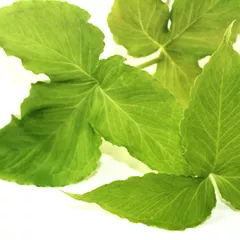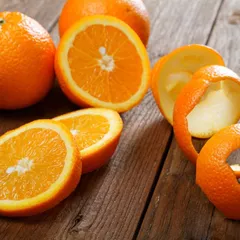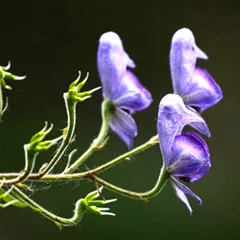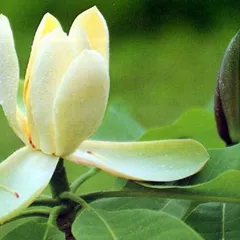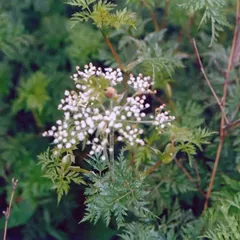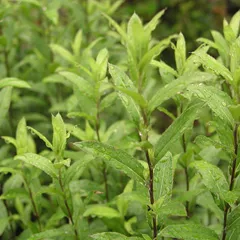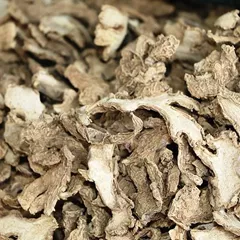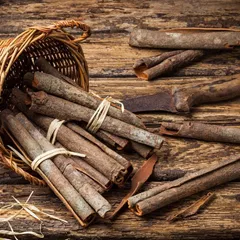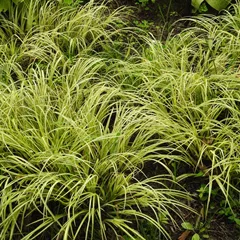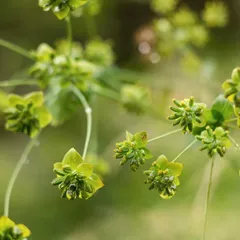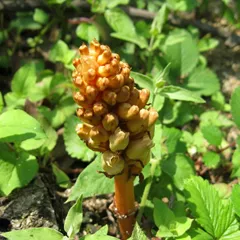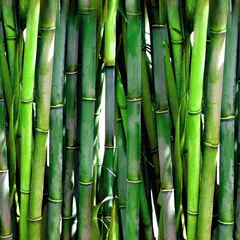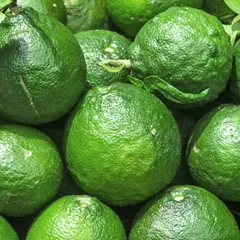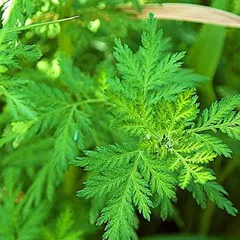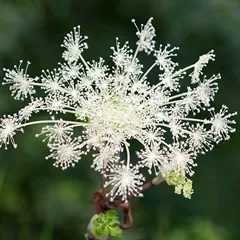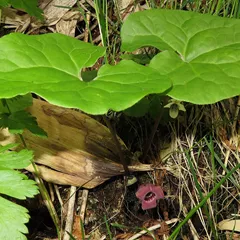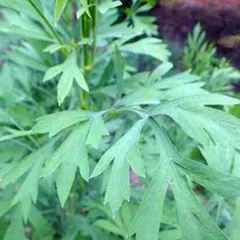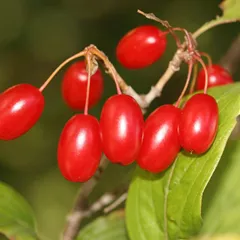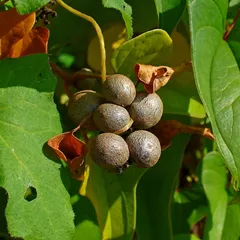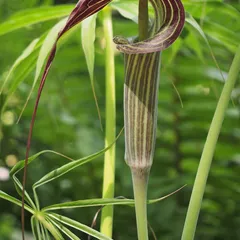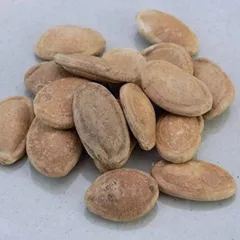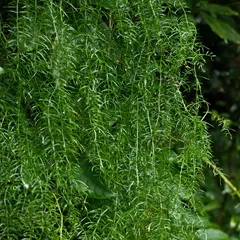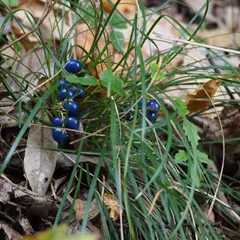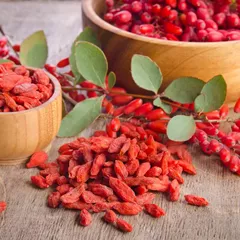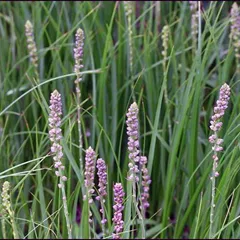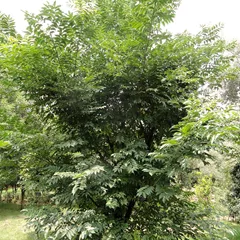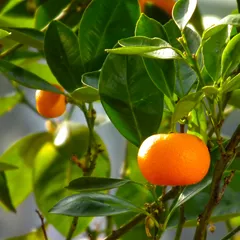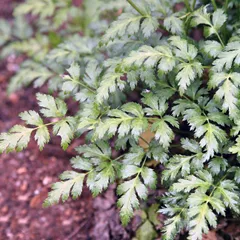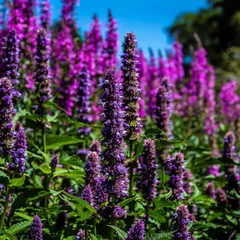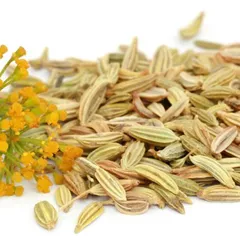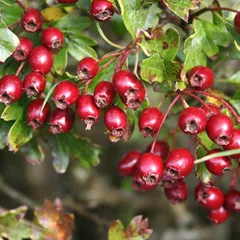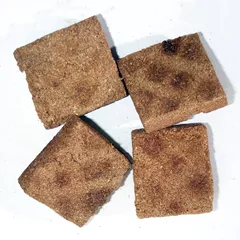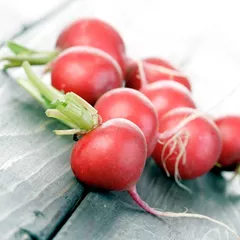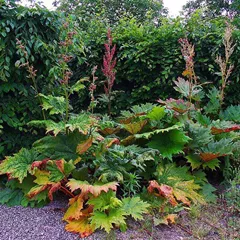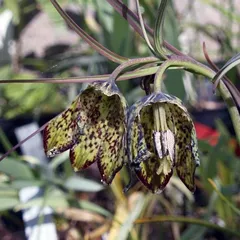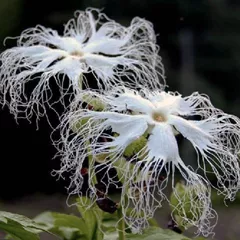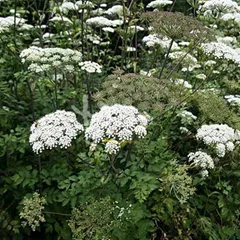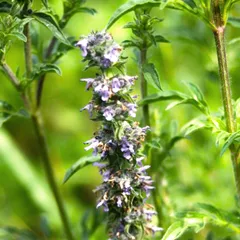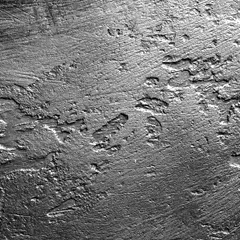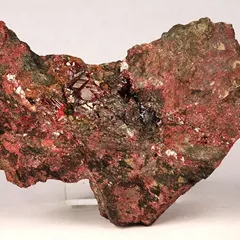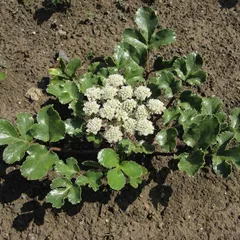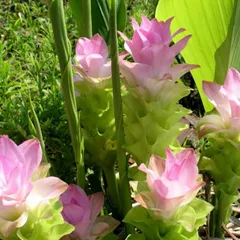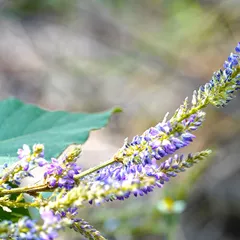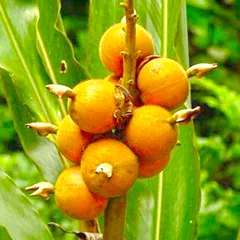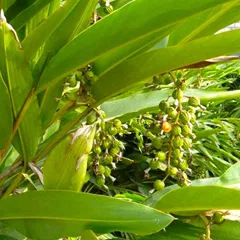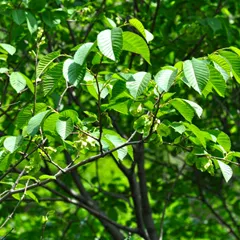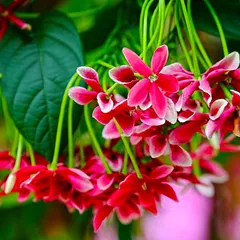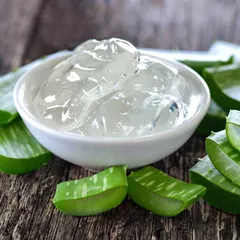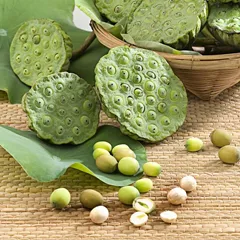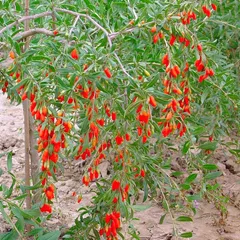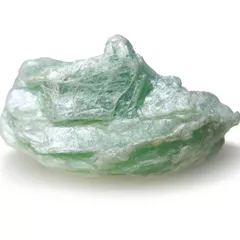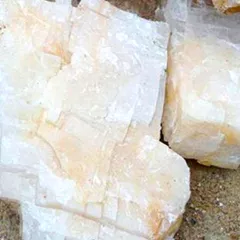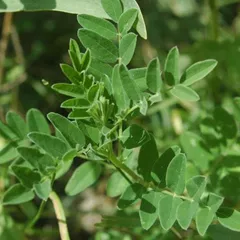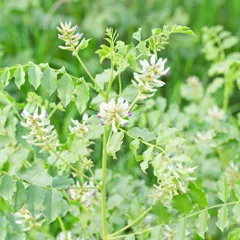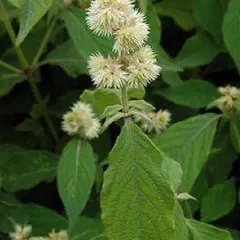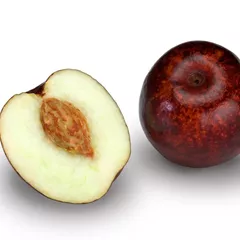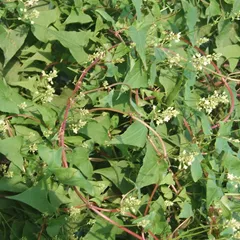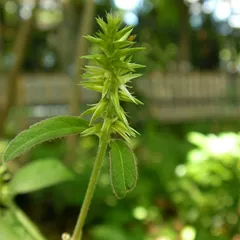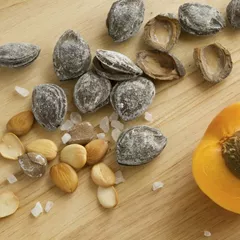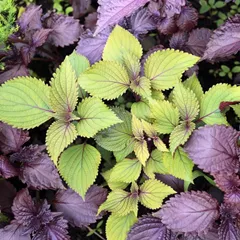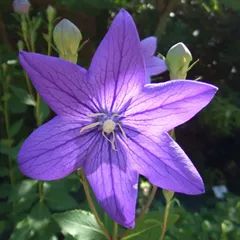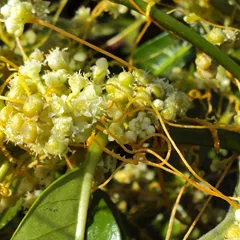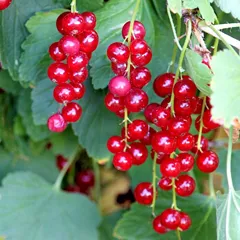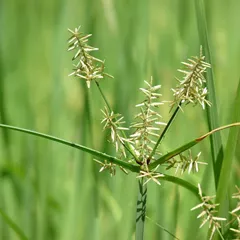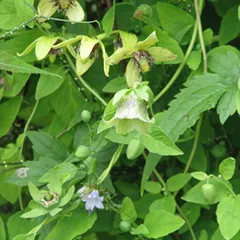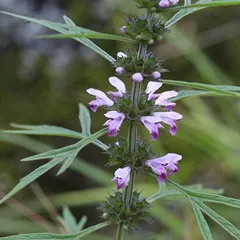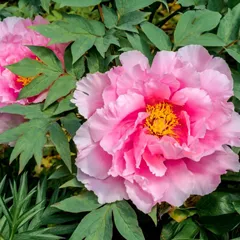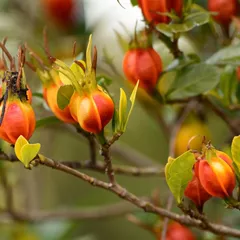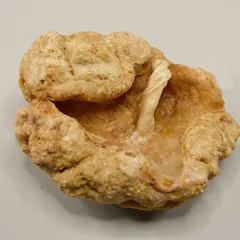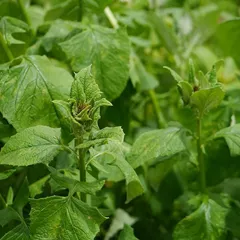Fu Ling
Fu Ling
English: Poria-cocos mushrooms
Chinese: 茯苓
Use of Fu Ling (poria-cocos mushrooms) in TCM
Please note that you should never self-prescribe TCM ingredients. A TCM ingredient is almost never eaten on its own but as part of a formula containing several ingredients that act together. Please consult a professional TCM practitioner, they will be best able to guide you.
Preparation: Soak in water, wash, steam slightly, remove the outside skin, cut into pieces or thick slices, dry.
Dosage: 10 to 15g
Main actions according to TCM*: Encourages urination and drains Dampness. Tonic to the Spleen/Stomach. Assists the Heart and calms the Spirit.
Primary conditions or symptoms for which Fu Ling may be prescribed by TCM doctors*: Insomnia Oliguria Diarrhea Palpitations Restlessness
Contraindications*: Should not be used when there is frequent and copious urination when associated with a Cold Deficiency.
Common TCM formulas in which Fu Ling is used*
Gui Zhi Fu Ling Wan
Source date: 220 AD
Number of ingredients: 5 herbs
Formula key actions: Promotes Blood and lymphatic circulation, thus eleminates Blood Stagnation. Softens and resolves hard lumps such as cysts and fibroids.
Conditions targeted*: InfertilityDysmenorrhea and others
Fu Ling is a king ingredient in Gui Zhi Fu Ling Wan. Like the name indicates, it means it has more power than other ingredients in the formula.
In Gui Zhi Fu Ling Wan, Fu Ling helps promote the downward circulation of Blood in cases of Blood Stagnation. It also nourishes the Qi of the Heart and Spleen, quiets the Heart, and calms the Mind (Shen), all of which helps calm the fetus in case this formula is taken by a pregnant woman. Poria-cocos mushrooms also have a strong diuretic action and hence help eliminate any Phlegm / Dampness that would complicate the Blood Stagnation.
Wu Pi Yin
Source date: 1107 AD
Number of ingredients: 5 herbs
Formula key actions: Reduces edema, diuretic. Regulates and strengthens Spleen Qi.
Conditions targeted*: Pre-eclampsiaProtein-deficiency edema and others
Fu Ling is a king ingredient in Wu Pi Yin. Like the name indicates, it means it has more power than other ingredients in the formula.
In Wu Pi Yin, Fu Ling leaches out Dampness, promotes urination, and strengthens the transportive function of the Spleen.
Ling Gui Zhu Gan Tang
Source date: 220 AD
Number of ingredients: 4 herbs
Formula key actions: Warms and transforms Phlegm-Fluids. Strengthens the Spleen. Resolves Dampness.
Conditions targeted*: Meniere's diseaseBasilar insufficiency and others
Fu Ling is a king ingredient in Ling Gui Zhu Gan Tang. Like the name indicates, it means it has more power than other ingredients in the formula.
In Ling Gui Zhu Gan Tang, Fu Ling strengthens the Spleen and release Dampness. It thereby transforms Phlegm-Fluids by addressing the root of this disorder which is the malfunction of metabolism of Body Fluids.
The combination of Fu Ling and Gui Zhi (Cinnamon twigs) is a delicate way of dealing with mucus and Phlegm accumulation due to cold. One increases the Body Fluids circulation, while the other warms the Qi flow.
Shen Ling Bai Zhu San
Source date: 1107 AD
Number of ingredients: 10 herbs
Formula key actions: Augments the Qi. Strengthens the Spleen. Leaches out Dampness. Stops diarrhea.
Conditions targeted*: Chronic gastritisEnteritis and others
Fu Ling is a king ingredient in Shen Ling Bai Zhu San. Like the name indicates, it means it has more power than other ingredients in the formula.
In Shen Ling Bai Zhu San, Fu Ling leaches out Dampness and assists the other key herbs in strengthening the Spleen.
Wu Ji San
Source date: 846 AD
Number of ingredients: 15 herbs
Formula key actions: Releases the Exterior. Warms the Interior. Smoothes the flow of Qi. Transforms Phlegm. Invigorates the Blood. Reduces Stagnation.
Conditions targeted*: BronchiolitisSciatica and others
Fu Ling is a king ingredient in Wu Ji San. Like the name indicates, it means it has more power than other ingredients in the formula.
In Wu Ji San, Fu Ling strengthens the Spleen and transform Phlegm.
Wu Ling San
Source date: 220 AD
Number of ingredients: 5 herbs
Formula key actions: Promotes urination,. Warms the Yang. Strengthens the Spleen. Promotes Qi transformation function. Drains Dampness. Clears edema.
Conditions targeted*: EdemaGlomerulonephritis and others
Fu Ling is a deputy ingredient in Wu Ling San. This means it helps the king ingredient(s) treat the main pattern or it serves to treat a coexisting pattern.
In Wu Ling San, Fu Ling is particularly effective in leaching out Dampness by promoting urination, strengthening the Spleen and assisting the Yang.
Er Chen Tang
Source date: 1148 AD
Number of ingredients: 5 herbs
Formula key actions: Dries Damp and dispels Phlegm. Regulates Qi and harmonizes the Middle Burner (Stomach and Spleen).
Conditions targeted*: Upper respiratory tract infectionsChronic bronchitis and others
Fu Ling is a deputy ingredient in Er Chen Tang. This means it helps the king ingredient(s) treat the main pattern or it serves to treat a coexisting pattern.
In Er Chen Tang, Fu Ling leaches out Dampness from the Middle-Burner and strengthens the Spleen. It also resolves the palpitations and dizziness often caused by the upward-rising Phlegm-Dampness.
A key Chinese medical text explains its role as such: "Fu Ling is an herb that focuses on treating Phlegm. The root of Phlegm is water. Fu Ling is able to move water and is also able to move Dampness".
Zhen Wu Tang
Source date: 220 AD
Number of ingredients: 5 herbs
Formula key actions: Warms and tonifies the Yang and Qi of the Spleen and Kidneys. Eliminates Dampness.
Conditions targeted*: Congestive heart failureChronic glomerulonephritis and others
Fu Ling is a deputy ingredient in Zhen Wu Tang. This means it helps the king ingredient(s) treat the main pattern or it serves to treat a coexisting pattern.
In Zhen Wu Tang, Fu Ling drains through the urine the Dampness and pathogenic water that has been retained in the body.
Fu Zi Tang
Source date: 220 AD
Number of ingredients: 5 herbs
Formula key actions: Warms the Meridians. Assists the Yang. Dispels Cold. Transforms Dampness.
Conditions targeted*: MigraineCluster headache and others
Fu Ling is a deputy ingredient in Fu Zi Tang. This means it helps the king ingredient(s) treat the main pattern or it serves to treat a coexisting pattern.
Ban Xia Hou Pu Tang
Source date: 220 AD
Number of ingredients: 5 herbs
Formula key actions: Regulates the flow of Qi, treats esophageal spasm. Clears Phlegm.
Conditions targeted*: Globus hystericusNeurosis and others
Fu Ling is a deputy ingredient in Ban Xia Hou Pu Tang. This means it helps the king ingredient(s) treat the main pattern or it serves to treat a coexisting pattern.
In Ban Xia Hou Pu Tang, Fu Ling leaches out Dampness and assists Crow-dipper rhizome, the key herb in this formula, in transforming Phlegm.
Ren Shen Yang Rong Tang
Source date: 1174 AD
Number of ingredients: 14 herbs
Formula key actions: Tonifies Qi and Blood. Nourishes the Heart. Calms the spirit.
Conditions targeted*: AnemiaNonhealing ulcers and others
Fu Ling is a deputy ingredient in Ren Shen Yang Rong Tang. This means it helps the king ingredient(s) treat the main pattern or it serves to treat a coexisting pattern.
In Ren Shen Yang Rong Tang, Fu Ling helps Ginseng tonify the Qi and resolve Dampness
Xiong Gui Er Chen Tang
Source date: 1575 AD
Number of ingredients: 7 herbs
Formula key actions: Resolves Damp-Phlegm. Nourishes Blood.
Fu Ling is a deputy ingredient in Xiong Gui Er Chen Tang. This means it helps the king ingredient(s) treat the main pattern or it serves to treat a coexisting pattern.
In Xiong Gui Er Chen Tang, Fu Ling supports the actions of the chief ingredients by leaching out Dampness from the Middle Burner and strengthening the Spleen. It also resolves the palpitations and dizziness caused by the upward-rising Phlegm and Dampness. In this manner, it treats the root of the disorder.
Ba Zhen Tang
Source date: 1326 AD
Number of ingredients: 10 herbs
Formula key actions: Tonifies and augments Qi. Tonifies and augments Blood.
Conditions targeted*: AnemiaHepatitis and others
Fu Ling is a deputy ingredient in Ba Zhen Tang. This means it helps the king ingredient(s) treat the main pattern or it serves to treat a coexisting pattern.
In Ba Zhen Tang, Fu Ling strengthens the Spleen and dry Dampness.
Wei Ling Tang
Source date: 1481 AD
Number of ingredients: 9 herbs
Formula key actions: Promotes urination. Warms the Yang. Strengthens the Spleen. Drains Dampness. Promotes the movement of Qi. Harmonizes the Stomach.
Conditions targeted*: EdemaGastritis and others
Fu Ling is a deputy ingredient in Wei Ling Tang. This means it helps the king ingredient(s) treat the main pattern or it serves to treat a coexisting pattern.
In Wei Ling Tang, Fu Ling is particularly effective in leaching out Dampness by promoting urination. It also strengthens the Spleen by supporting Yang.
Hui Yang Jiu Ji Tang
Source date: 1445 AD
Number of ingredients: 11 herbs
Formula key actions: Restores and revives the Yang. Augments the Qi. Revives the pulse.
Conditions targeted*: Myocardial infarctionCardiogenic shock and others
Fu Ling is a deputy ingredient in Hui Yang Jiu Ji Tang. This means it helps the king ingredient(s) treat the main pattern or it serves to treat a coexisting pattern.
In Hui Yang Jiu Ji Tang, Fu Ling augments the Spleen and Stomach. Strengthening the Middle Burner serves to regulate the dispersal of Yang without hindering its restoration.
Ren Shen Ge Jie San
Source date: 1047 AD
Number of ingredients: 8 herbs
Formula key actions: Tonifies the Qi. Augments the Kidneys. Stops coughing. Arrests wheezing.
Conditions targeted*: Bronchial asthmaEmphysema and others
Fu Ling is a deputy ingredient in Ren Shen Ge Jie San. This means it helps the king ingredient(s) treat the main pattern or it serves to treat a coexisting pattern.
In Ren Shen Ge Jie San, Fu Ling benefits the Spleen by draining Dampness.
With Liquorice, it focuses on the treatment of Spleen earth. They also treat problems of Lung metal and Kidney water via the generating and controlling relationships of the five phases.
Ding Zhi Wan
Source date: 650 AD
Number of ingredients: 4 herbs
Formula key actions: Tonifies the Heart Qi . Pacifies timidity. Calms the Mind .
Conditions targeted*: General anxiety disorderObsessive-compulsive disorder and others
Fu Ling is a deputy ingredient in Ding Zhi Wan. This means it helps the king ingredient(s) treat the main pattern or it serves to treat a coexisting pattern.
In Ding Zhi Wan, Fu Ling is bland and neutral. It calms the Heart and the Mind. It is specifically
indicated for palpitations, insomnia, or forgetfulness due to Heart Deficiency or internal obstruction of turbid Phlegm.
The Key and deputy herbs focus on the Heart to tonify its Qi, promoting the elimination of Dampness and, via the fluid enriching action of Ginseng, ensure that the physiological Body Fluids are not damaged.
Si Jun Zi Tang
Source date: 1107 AD
Number of ingredients: 4 herbs
Formula key actions: Tonifies Qi. Strengthens the Spleen and Stomach.
Conditions targeted*: Chronic gastritisPeptic ulcers and others
Fu Ling is an assistant ingredient in Si Jun Zi Tang. This means that it either serves to reinforces the effect of other ingredients or it moderates their toxicity.
In Si Jun Zi Tang, Fu Ling removes Dampness and assists Ginseng and Codonopsis root in strengthening the Spleen.
Liu Jun Zi Tang
Source date: 1107
Number of ingredients: 6 herbs
Formula key actions: Tonifies Qi. Strengthens the Spleen and Stomach. Clears Phlegm and mucus. Promotes appetite.
Conditions targeted*: AnorexiaPeptic ulcers and others
Fu Ling is an assistant ingredient in Liu Jun Zi Tang. This means that it either serves to reinforces the effect of other ingredients or it moderates their toxicity.
In Liu Jun Zi Tang, Fu Ling removes Dampness and assists Ginseng or Codonopsis root in strengthening the Spleen.
Jia Wei Xiao Yao San
Source date: Ming dynasty
Number of ingredients: 10 herbs
Formula key actions: Clears Liver and Spleen Qi Stagnation. Tonifies Spleen. Clears Deficient Heat. Nourishes the blood.
Conditions targeted*: InfertilityMenorrhagia and others
Fu Ling is an assistant ingredient in Jia Wei Xiao Yao San. This means that it either serves to reinforces the effect of other ingredients or it moderates their toxicity.
In Jia Wei Xiao Yao San, Fu Ling strengthens the Spleen.
Xiao Yao San
Source date: 1107 AD
Number of ingredients: 6 herbs
Formula key actions: Harmonizes the function of Liver and Spleen. Relieves Liver Qi stagnation. Nourishes the Blood.
Conditions targeted*: HepatitisCholecystitis and others
Fu Ling is an assistant ingredient in Xiao Yao San. This means that it either serves to reinforces the effect of other ingredients or it moderates their toxicity.
In Xiao Yao San, Fu Ling strengthens the Spleen.
Ban Xia Bai Zhu Tian Ma Tang
Source date: 1732 AD
Number of ingredients: 8 herbs
Formula key actions: Dries and dissolves Phlegm. Strengthens the Spleen. Smoothes the Liver and calms Liver Wind (antispasmodic).
Conditions targeted*: Meniere's diseaseHypertension and others
Fu Ling is an assistant ingredient in Ban Xia Bai Zhu Tian Ma Tang. This means that it either serves to reinforces the effect of other ingredients or it moderates their toxicity.
In Ban Xia Bai Zhu Tian Ma Tang, Fu Ling strengthens the Spleen and leaches out Dampness.
Wen Dan Tang
Source date: 1174 AD
Number of ingredients: 8 herbs
Formula key actions: Clears Phlegm. Clears Gallbladder. Regulates Qi. Harmonizes the Stomach.
Conditions targeted*: HypertensionAngina and others
Fu Ling is an assistant ingredient in Wen Dan Tang. This means that it either serves to reinforces the effect of other ingredients or it moderates their toxicity.
In Wen Dan Tang, Fu Ling , together with Liquorice (Gan Cao), strengthens the Spleen, leaches out Dampness, and harmonizes the functions of the Middle Burner.
Hao Qin Qing Dan Tang
Source date: Qing Dynasty
Number of ingredients: 10 herbs
Formula key actions: Clears Heat and relieves acute conditions of the Gallbladder. Relieves acute Damp-Heat syndromes. Resolves Phlegm. Harmonizes the Stomach.
Conditions targeted*: CholecystitisIcteric hepatitis and others
Fu Ling is an assistant ingredient in Hao Qin Qing Dan Tang. This means that it either serves to reinforces the effect of other ingredients or it moderates their toxicity.
In Hao Qin Qing Dan Tang, Fu Ling , together with Liquorice (Gan Cao), Talc (Hua Shi) and Natural Indigo (Qing Dai), the other assistants in this formula, drain Damp Heat through the urine to break Stagnation in the Triple Burner.
Du Huo Ji Sheng Tang
Source date: 650 AD
Number of ingredients: 15 herbs
Formula key actions: Anti-rheumatic, clears Wind, Cold and Damp Stagnation. Strengthens the function of the Liver and Kidney. Tonifies Qi and Blood.
Conditions targeted*: Chronic lower back painSciatica and others
Fu Ling is an assistant ingredient in Du Huo Ji Sheng Tang. This means that it either serves to reinforces the effect of other ingredients or it moderates their toxicity.
Liu Wei Di Huang Wan
Source date: 1119 AD
Number of ingredients: 6 herbs
Formula key actions: Enriches the yin and nourishes the Kidneys.
Conditions targeted*: Chronic nephritisProstate diseases and others
Fu Ling is an assistant ingredient in Liu Wei Di Huang Wan. This means that it either serves to reinforces the effect of other ingredients or it moderates their toxicity.
In Liu Wei Di Huang Wan, Fu Ling is a bland herb that leaches out Dampness from the Spleen. It notably helps Yam (Shan Yao) strengthen the transportive functions of the Spleen. This prevents the formula from clogging up the digestive process and reinforces the Spleen's function of nourishing the body.
Poria-cocos mushrooms also works together with the Water plantain (Ze Xie) to improve the metabolism of Fluids and promote urination, thereby preventing a buildup of stagnant Fluids.
Ba Wei Di Huang Wan
Source date: 220 AD
Number of ingredients: 8 herbs
Formula key actions: Tonifies Yang. Warms the Kidneys and lower extremities.
Conditions targeted*: Diabetes mellitusDiabetes insipidus and others
Fu Ling is an assistant ingredient in Ba Wei Di Huang Wan. This means that it either serves to reinforces the effect of other ingredients or it moderates their toxicity.
In Ba Wei Di Huang Wan, Fu Ling is a bland herb that leaches out Dampness from the Spleen. It notably helps Yam (Shan Yao) strengthen the transportive functions of the Spleen. This prevents the formula from clogging up the digestive process and reinforces the Spleen's function of nourishing the body.
Poria-cocos mushrooms also works together with the Water plantain (Ze Xie) to improve the metabolism of Fluids and promote urination, thereby preventing a buildup of stagnant Fluids.
Qing Qi Hua Tan Wan
Source date: 1584 AD
Number of ingredients: 8 herbs
Formula key actions: Clears Heat. Transforms Phlegm. Directs Rebellious Qi downwards. Stops coughing.
Conditions targeted*: PneumoniaChronic bronchitis and others
Fu Ling is an assistant ingredient in Qing Qi Hua Tan Wan. This means that it either serves to reinforces the effect of other ingredients or it moderates their toxicity.
In Qing Qi Hua Tan Wan, Fu Ling works together with Crow-dipper rhizome (Ban Xia) and Apricot seeds (Xing Ren), two other assistants in this formula, to facilitate the flow of Qi in the Lungs.
Ling Gan Wu Wei Jiang Xin Tang
Source date: 220 AD
Number of ingredients: 5 herbs
Formula key actions: Warms the Lungs. Transforms congested Fluids.
Conditions targeted*: Chronic bronchitisChronic asthma and others
Fu Ling is an assistant ingredient in Ling Gan Wu Wei Jiang Xin Tang. This means that it either serves to reinforces the effect of other ingredients or it moderates their toxicity.
In Ling Gan Wu Wei Jiang Xin Tang, Fu Ling strengthens the Spleen and leaches out Dampness and thereby treating the Cold-Phlegm problem at its source.
Qi Ju Di Huang Wan
Source date: 1350 AD
Number of ingredients: 8 herbs
Formula key actions: Nourishes Kidney and Liver Yin. Improves vision.
Conditions targeted*: Diabetes mellitusDiabetes insipidus and others
Fu Ling is an assistant ingredient in Qi Ju Di Huang Wan. This means that it either serves to reinforces the effect of other ingredients or it moderates their toxicity.
In Qi Ju Di Huang Wan, Fu Ling is a bland herb that leaches out Dampness from the Spleen. It notably helps Yam (Shan Yao) strengthen the transportive functions of the Spleen. This prevents the formula from clogging up the digestive process and reinforces the Spleen's function of nourishing the body.
Poria-cocos mushrooms also works together with the Water plantain (Ze Xie) to improve the metabolism of Fluids and promote urination, thereby preventing a buildup of stagnant Fluids.
Tian Wang Bu Xin Dan
Source date: 16th century
Number of ingredients: 14 herbs
Formula key actions: Enriches the Yin. Nourishes the Blood. Clears Heat. Calms the Mind.
Conditions targeted*: Perimenopausal syndromeChronic urticaria and others
Fu Ling is an assistant ingredient in Tian Wang Bu Xin Dan. This means that it either serves to reinforces the effect of other ingredients or it moderates their toxicity.
In Tian Wang Bu Xin Dan, Fu Ling supports the Heart Qi.
Zuo Gui Yin
Source date: 1624 AD
Number of ingredients: 6 herbs
Formula key actions: Nourishes the Yin. Tonifies the Kidneys.
Fu Ling is an assistant ingredient in Zuo Gui Yin. This means that it either serves to reinforces the effect of other ingredients or it moderates their toxicity.
In Zuo Gui Yin, Fu Ling drains Dampness.
Zhi Bo Di Huang Wan
Fu Ling is an assistant ingredient in Zhi Bo Di Huang Wan. This means that it either serves to reinforces the effect of other ingredients or it moderates their toxicity.
In Zhi Bo Di Huang Wan, Fu Ling is a bland herb that leaches out Dampness from the Spleen.
Here it notably helps Yam (Shan Yao) strengthen the transportive functions of the Spleen. This prevents the formula from clogging up the digestive process and reinforces the Spleen's function of nourishing the body.
Poria-cocos mushrooms also works together with the Water plantain (Ze Xie) to improve the metabolism of Fluids and promote urination, thereby preventing a buildup of stagnant fluids.
Di Tan Tang
Source date: 1470 AD
Number of ingredients: 9 herbs
Formula key actions: Removes Phlegm. Opens the sensory orifices. Tonifies Qi.
Conditions targeted*: Cerebrovascular accidentSeizure disorder and others
Fu Ling is an assistant ingredient in Di Tan Tang. This means that it either serves to reinforces the effect of other ingredients or it moderates their toxicity.
In Di Tan Tang, Fu Ling strengthens the Spleen by draining Dampness.
Huang Lian Wen Dan Tang
Source date: 1852 AD
Number of ingredients: 7 herbs
Formula key actions: Clears Hot Phlegm. Clears Gallbladder Heat. Regulates Qi. Harmonizes the Stomach.
Conditions targeted*: HypertensionAngina and others
Fu Ling is an assistant ingredient in Huang Lian Wen Dan Tang. This means that it either serves to reinforces the effect of other ingredients or it moderates their toxicity.
In Huang Lian Wen Dan Tang, Fu Ling , together with Liquorice (Gan Cao), strengthens the Spleen, leaches out Dampness, and harmonizes the functions of the Middle Burner.
Huo Xiang Zheng Qi San
Source date: 1107 AD
Number of ingredients: 11 herbs
Formula key actions: Releases the Exterior. Transforms Dampness. Regulates Qi. Harmonizes the Middle Burner.
Conditions targeted*: GastroenteritisStomach flu and others
Fu Ling is an assistant ingredient in Huo Xiang Zheng Qi San. This means that it either serves to reinforces the effect of other ingredients or it moderates their toxicity.
In Huo Xiang Zheng Qi San, Fu Ling strengthens the Spleen and transforms Dampness.
Nuan Gan Jian
Source date: 1624 AD
Number of ingredients: 8 herbs
Formula key actions: Warms the Liver and Kidneys. Promotes the movement of Qi. Alleviates pain.
Conditions targeted*: VaricoceleHydrocele and others
Fu Ling is an assistant ingredient in Nuan Gan Jian. This means that it either serves to reinforces the effect of other ingredients or it moderates their toxicity.
In Nuan Gan Jian, Fu Ling leaches out Dampness and strengthens the Spleen to eliminate the Yin Excess that invariably accompanies Yang Deficiency.
Ba Xian Chang Shou Wan
Source date: 1615 AD
Number of ingredients: 8 herbs
Formula key actions: Treats Yin Deficiency of the Lungs and Kidneys.
Fu Ling is an assistant ingredient in Ba Xian Chang Shou Wan. This means that it either serves to reinforces the effect of other ingredients or it moderates their toxicity.
In Ba Xian Chang Shou Wan, Fu Ling is a bland herb that leaches out Dampness from the Spleen. It notably helps Yam (Shan Yao) strengthen the transportive functions of the Spleen. This prevents the formula from clogging up the digestive process and reinforces the Spleen's function of nourishing the body.
Poria-cocos mushrooms also works together with the Water plantain (Ze Xie) to improve the metabolism of Fluids and promote urination, thereby preventing a buildup of stagnant Fluids.
Bao He Wan
Source date: 1481 AD
Number of ingredients: 7 herbs
Formula key actions: Reduces food stagnation. Harmonizes the Stomach.
Conditions targeted*: GastroenteritisChronic gastritis and others
Fu Ling is an assistant ingredient in Bao He Wan. This means that it either serves to reinforces the effect of other ingredients or it moderates their toxicity.
In Bao He Wan, Fu Ling strengthens the Spleen and leaches out Dampness, thereby harmonizing the Middle Burner to stop the diarrhea
Zhi Shi Dao Zhi Wan
Source date: 1247 AD
Number of ingredients: 8 herbs
Formula key actions: Reduces and guides out stagnation and accumulation. Drains heat. Dispels dampness.
Fu Ling is an assistant ingredient in Zhi Shi Dao Zhi Wan. This means that it either serves to reinforces the effect of other ingredients or it moderates their toxicity.
In Zhi Shi Dao Zhi Wan, Fu Ling promotes water metabolism to facilitate the draining of Damp-Heat via the urine.
Bei Mu Gua Lou San
Source date: 1732 AD
Number of ingredients: 6 herbs
Formula key actions: Moistens the Lungs. Clears Heat. Regulates Qi. Resolve Phlegm.
Conditions targeted*: PneumoniaPulmonary tuberculosis and others
Fu Ling is an assistant ingredient in Bei Mu Gua Lou San. This means that it either serves to reinforces the effect of other ingredients or it moderates their toxicity.
In Bei Mu Gua Lou San, Fu Ling strengthens the Spleen. Together with the other assistant herb Red Tangerine Peel, it strengthens the Spleen's Body Fluids transportation and transformation functions, which is critical for treating the pattern with Dryness and Phlegm.
A well functioning Spleen is essential in Body Fluids formation and then transportation to the Lungs. The Spleen also helps resolve Dampness and Phlegm.
Ren Shen Bai Du San
Source date: 1119 AD
Number of ingredients: 12 herbs
Formula key actions: Releases the Exterior. Dispels Wind and Dampness. Augments Qi.
Conditions targeted*: Common coldInfluenza and others
Fu Ling is an assistant ingredient in Ren Shen Bai Du San. This means that it either serves to reinforces the effect of other ingredients or it moderates their toxicity.
In Ren Shen Bai Du San, Fu Ling transforms Phlegm and strengthens the Spleen, when combing with Hogfennel root. It also releases Dampness and promotes urination. It is able to tonify without causing Stagnation or retention of pathogenic influences.
Jing Fang Bai Du San
Source date: 1550 AD
Number of ingredients: 13 herbs
Formula key actions: Releases the Exterior. Dispels Wind and Dampness. Augments Qi.
Conditions targeted*: Common coldInfluenza and others
Fu Ling is an assistant ingredient in Jing Fang Bai Du San. This means that it either serves to reinforces the effect of other ingredients or it moderates their toxicity.
In Jing Fang Bai Du San, Fu Ling transforms Phlegm and strengthens the Spleen, when combing with Hogfennel root. It also releases Dampness and promotes urination. It is able to tonify without causing Stagnation or retention of pathogenic influences.
Shu Jing Huo Xue Tang
Source date: 1587 AD
Number of ingredients: 16 herbs
Formula key actions: Expels Wind Damp from the Channels. Invigorates Blood. Unblocks the channels.
Conditions targeted*: ArthralgiaBell's palsy and others
Fu Ling is an assistant ingredient in Shu Jing Huo Xue Tang. This means that it either serves to reinforces the effect of other ingredients or it moderates their toxicity.
In Shu Jing Huo Xue Tang, Fu Ling encourages urination and drains Dampness.
Chai Hu Jia Long Gu Mu Li Tang
Source date: 220 AD
Number of ingredients: 12 herbs
Formula key actions: Unblocks the three Yang warps. Sedates and calms the Spirit.
Conditions targeted*: NeurosisDepression and others
Fu Ling is an assistant ingredient in Chai Hu Jia Long Gu Mu Li Tang. This means that it either serves to reinforces the effect of other ingredients or it moderates their toxicity.
In Chai Hu Jia Long Gu Mu Li Tang, Fu Ling works with and Poria cocos mushroom to strengthen the Qi of the Middle Burner, and makes esure that it is not further damaged by the treatment. They cause a mild calming effect.
It also increases and promotes urination.
Qing Pi Tang
Source date: 1253 AD
Number of ingredients: 9 herbs
Formula key actions: Harmonizes and resolves. Transforms Phlegm and dries Dampness. Improves the Spleen's transportive function. Clears Heat. Moves Qi.
Conditions targeted*: Malaria and others
Fu Ling is an assistant ingredient in Qing Pi Tang. This means that it either serves to reinforces the effect of other ingredients or it moderates their toxicity.
In Qing Pi Tang, Fu Ling strengthens the Spleen, augments the Qi, and dispels Dampness.
The combination of Atractylodes rhizome and Poria-cocos mushroom removes the cause of Dampness helps to eliminate any Excessive Body Fluid from the body.
Sheng Tie Luo Yin
Source date: 1732 AD
Number of ingredients: 15 herbs
Formula key actions: Sedates the Heart . Clears Phlegm. Clears Fire. Calms the Mind.
Conditions targeted*: EpilepsyBi-Polar disorder and others
Fu Ling is an assistant ingredient in Sheng Tie Luo Yin. This means that it either serves to reinforces the effect of other ingredients or it moderates their toxicity.
In Sheng Tie Luo Yin, Fu Ling treats Phlegm at its source by improving the function of the Spleen and Qi.
Qi Ge San
Source date: 1732 AD
Number of ingredients: 8 herbs
Formula key actions: Regulates Qi and removes Stagnation. Moistens Dryness. Transforms Phlegm.
Conditions targeted*: EsophagitisEsophageal diverticulum and others
Fu Ling is an assistant ingredient in Qi Ge San. This means that it either serves to reinforces the effect of other ingredients or it moderates their toxicity.
In Qi Ge San, Fu Ling removes Dampness and transforms Phlegm and
gently supports the Middle Burner in its production of Blood without drying effect.
Together, all the assistant herbs effectively facilitate the
downward-directing of turbid Phlegm and support the ascent of the clear Yang to unblock the Qi dynamic and eliminate Excess Pernicious Factors without causing further Dryness.
Ge Hua Jie Cheng San
Source date: 13th century
Number of ingredients: 13 herbs
Formula key actions: Separates and reduces alcohol-dampness. Warms the Middle. Strengthens the Spleen .
Conditions targeted*: HangoversAlcoholism and others
Fu Ling is an assistant ingredient in Ge Hua Jie Cheng San. This means that it either serves to reinforces the effect of other ingredients or it moderates their toxicity.
In Ge Hua Jie Cheng San, Fu Ling dispels Damp-Heat by promoting urination.
Bu Dai Wan
Source date: Late Ming
Number of ingredients: 8 herbs
Formula key actions: Expels roundworms. Reduces nutritional impairment in children . Tonifies the Spleen and Stomach.
Conditions targeted*: AscariasisParasitic infestation and others
Fu Ling is an assistant ingredient in Bu Dai Wan. This means that it either serves to reinforces the effect of other ingredients or it moderates their toxicity.
In Bu Dai Wan, Fu Ling benefit the Spleen and fortify the Qi of the Middle Burner.
Shi Wei Bai Du San
Source date: 1760-1835 AD
Number of ingredients: 10 herbs
Formula key actions: Dispels Wind and transforms Dampness. Clears Toxic Heat .
Conditions targeted*: AcneBoils and others
Fu Ling is an assistant ingredient in Shi Wei Bai Du San. This means that it either serves to reinforces the effect of other ingredients or it moderates their toxicity.
In Shi Wei Bai Du San, Fu Ling removes Dampness and at the same time enhances the body's ability to expel Toxic-Heat through urination.
Qing Xin Lian Zi Yin
Source date: 1107 AD
Number of ingredients: 9 herbs
Formula key actions: Clears the Heart. Augments the Qi and Yin. Stops turbid painful urinary dribbling.
Conditions targeted*: Chronic nephritisChronic prostatitis and others
Fu Ling is an assistant ingredient in Qing Xin Lian Zi Yin. This means that it either serves to reinforces the effect of other ingredients or it moderates their toxicity.
In Qing Xin Lian Zi Yin, Fu Ling promotes urination and separates Heat from Dampness.
Gui Ling Gan Lu Yin
Source date: 1172 AD
Number of ingredients: 9 herbs
Formula key actions: Expels Summerheat. Clears Heat. Transforms Qi. Removes Dampness .
Conditions targeted*: Acute gastroenteritisCholera and others
Fu Ling is an assistant ingredient in Gui Ling Gan Lu Yin. This means that it either serves to reinforces the effect of other ingredients or it moderates their toxicity.
In Gui Ling Gan Lu Yin, Fu Ling promote urination and expel Dampness. Together, the four Dampness resolving assist herbs restore the ascending and descending functions of the Qi mechanism, transform the Bladder Qi , and alleviate sudden turmoil disorder.
Sheng Yang Yi Wei Tang
Source date: 1247 AD
Number of ingredients: 16 herbs
Formula key actions: Strengthens the Spleen. Augments the Qi. Raises the Yang. Releases Dampness.
Conditions targeted*: Atrophic gastritisChronic pelvic inflammatory disease and others
Fu Ling is an assistant ingredient in Sheng Yang Yi Wei Tang. This means that it either serves to reinforces the effect of other ingredients or it moderates their toxicity.
In Sheng Yang Yi Wei Tang, Fu Ling removes Dampness and assists Ginseng or Codonopsis root in strengthening the Spleen.
Dang Gui Shao Yao San
Source date: 220 AD
Number of ingredients: 7 herbs
Formula key actions: Nourishes the Liver Blood. Spreads the Liver Qi. Strengthens the Spleen. Resolves Dampness.
Conditions targeted*: Perimenstrual migrainesEndometritis and others
Fu Ling is an assistant ingredient in Dang Gui Shao Yao San. This means that it either serves to reinforces the effect of other ingredients or it moderates their toxicity.
In Dang Gui Shao Yao San, Fu Ling tonifies the Qi and leach out Dampness.
Ji Sheng Shen Qi Wan
Source date: 1695 AD
Number of ingredients: 10 herbs
Formula key actions: Tonifies and warms Kidney Yang.
Conditions targeted*: EdemaHeavy back and others
Fu Ling is an assistant ingredient in Ji Sheng Shen Qi Wan. This means that it either serves to reinforces the effect of other ingredients or it moderates their toxicity.
In Ji Sheng Shen Qi Wan, Fu Ling leaches out Dampness from the Spleen. It is paired with Yam to strengthen the transportive functions of the Spleen. This prevents the formula from clogging up the digestive process and reinforces the Spleen's function of nourishing the body. Fu Ling and Water plantain work together to improve the metabolism of Body Fluids an promote urination, thereby preventing a buildup of Stagnant Fluids.
Ming Mu Di Huang Wan
Source date: 1642 AD
Number of ingredients: 12 herbs
Formula key actions: Nourishes the Liver. Enriches the Kidneys. Improves the vision.
Fu Ling is an assistant ingredient in Ming Mu Di Huang Wan. This means that it either serves to reinforces the effect of other ingredients or it moderates their toxicity.
In Ming Mu Di Huang Wan, Fu Ling is a bland herb that leaches out Dampness from the Spleen. It notably helps Yam (Shan Yao) strengthen the transportive functions of the Spleen. This prevents the formula from clogging up the digestive process and reinforces the Spleen's function of nourishing the body.
Poria-cocos mushrooms also works together with the Water plantain (Ze Xie) to improve the metabolism of Fluids and promote urination, thereby preventing a buildup of stagnant Fluids.
Suan Zao Ren Tang
Source date: 220 AD
Number of ingredients: 5 herbs
Formula key actions: Nourishes the Blood. Calms the Mind and eliminates irritability . Clears Heat.
Conditions targeted*: InsomniaSleep walking and others
Fu Ling is an assistant ingredient in Suan Zao Ren Tang. This means that it either serves to reinforces the effect of other ingredients or it moderates their toxicity.
In Suan Zao Ren Tang, Fu Ling is sweet and bland. It calms the Mind and tonifies the Spleen and Stomach, along with bitter, sweet, and cooling Zhi Mu.
Qi Bao Mei Ran Dan
Source date: 1590 AD
Number of ingredients: 9 herbs
Formula key actions: Enriches the Kidney Yin. Nourishes the Liver Blood.
Conditions targeted*: AlopeciaPremature graying of the hair and others
Fu Ling is an assistant ingredient in Qi Bao Mei Ran Dan. This means that it either serves to reinforces the effect of other ingredients or it moderates their toxicity.
In Qi Bao Mei Ran Dan, Fu Ling assists the Bladder's draining function. It leaches out any Dampness or turbidity in the body.
Xing Su San
Source date: 1798 AD
Number of ingredients: 11 herbs
Formula key actions: Clears Dry-Cold. Disseminates the Lung Qi and relieves cough. Transforms thin mucus.
Conditions targeted*: Common coldBronchitis and others
Cang Fu Dao Tan Wan
Source date: 1817 AD
Number of ingredients: 8 herbs
Formula key actions: Resolves Dampness and Phlegm.
In Cang Fu Dao Tan Wan, Fu Ling resolves Dampness and Phlegm.
Tuo Li Xiao Du San
Source date: 1548 AD
Number of ingredients: 11 herbs
Formula key actions: Draws out toxicity. Expels pus from the interior. Tonifies Qi and Blood.
In Tuo Li Xiao Du San, Fu Ling removes Dampness
Wen Qi Hua Shi Tang
Source date: 1827 AD
Number of ingredients: 7 herbs
Formula key actions: Supports Kidney Yang. Supplies Spleen Qi. Expels Cold and Dampness from the Uterus.
In Wen Qi Hua Shi Tang, Fu Ling resolves Dampness
Ba Zhen Yi Mu Tang
Source date: 1624 AD
Number of ingredients: 9 herbs
Formula key actions: Tonifies Qi and Blood. Invigorates the Blood.
Conditions targeted*: Infertility and others
In Ba Zhen Yi Mu Tang, Fu Ling strengthens the Spleen and dry Dampness. Therefore it assists Ginseng in strengthening the Qi of the Spleen and Lungs.
Dan Zhi Xiao Yao San
Source date: 2002 AD
Number of ingredients: 8 herbs
Formula key actions: Clears Liver Fire from Stagnant Liver Qi.
In Dan Zhi Xiao Yao San, Fu Ling moves Qi and is specific for menstrual issues, especially from emotional stress.
Gui Shao Di Huang Tang
Source date: 1706 AD
Number of ingredients: 8 herbs
Formula key actions: Nourishes Blood. Nourishes Yin.
In Gui Shao Di Huang Tang, Fu Ling nourishes Liver and Kidney Yin
He Che Da Zao Wan
Number of ingredients: 11 herbs
Formula key actions: Tonifies the Kidneys. Strengthens the Directing and Penetrating Vessels. Regulates the periods.
In He Che Da Zao Wan, Fu Ling resolves Dampness
Qing Jing San
Source date: 1826 AD
Number of ingredients: 7 herbs
Formula key actions: Clears Blood-Heat. Stops bleeding.
In Qing Jing San, Fu Ling drains Dampness
Shen Qi Wan
Source date: 220 AD
Number of ingredients: 8 herbs
Formula key actions: Tonifies and warms Kidney Yang.
Conditions targeted*: Diabetes mellitusHyperaldosteronism and others
In Shen Qi Wan, Fu Ling leaches out Dampness from the Spleen. It is paired with Yam to strengthen the transportive functions of the Spleen. This prevents the formula from clogging up the digestive process and reinforces the Spleen's function of nourishing the body. Fu Ling and Water plantain work together to improve the metabolism of Body Fluids an promote urination, thereby preventing a buildup of Stagnant Fluids.
Xiang Sha Liu Jun Zi Tang
Source date: 1675 AD
Number of ingredients: 9 herbs
Formula key actions: Tonifies Spleen and Stomach Qi. Removes Dampness. Moves Qi. Alleviates pain.
In Xiang Sha Liu Jun Zi Tang, Fu Ling removes Dampness and assists Ginseng or Codonopsis root in strengthening the Spleen.
Ren Shen Zi Xie Tang
In Ren Shen Zi Xie Tang, Fu Ling tonifies Qi in order to nourish Blood
Shi Quan Da Bu Tang
Source date: 1180 AD
Number of ingredients: 10 herbs
Formula key actions: Warms and tonifies Qi. Warms and tonifies Blood.
Conditions targeted*: AnemiaNervous exhaustion and others
In Shi Quan Da Bu Tang, Fu Ling removes Dampness and assists Ginseng and Codonopsis root in strengthening the Spleen.
Xiang Sha Yang Wei Wan
Source date: 1587 AD
Number of ingredients: 13 herbs
Formula key actions: Strengthens and harmonizes the Spleen and Stomach. Resolves Dampness.
Conditions targeted*: Poor appetiteLoss of taste and others
In Xiang Sha Yang Wei Wan, Fu Ling removes Dampness from the Middle Burner by encouraging urination.
Key TCM concepts behind Fu Ling's properties
In Traditional Chinese Medicine (TCM), Fu Ling belongs to the 'Herbs that drain Dampness' category. These herbs are typically diuretics, meaning that they promotes the increased production of urine in order to remove Dampness that has accumulated in the body. According to TCM Dampness accumulates first in the lower limbs, causing edema and impaired movement. From there, if unchecked, it can move upward and impair digestion and eventually the respiratory system.
Furthermore Fu Ling is Neutral in nature. This means that Fu Ling typically doesn't affect the balance in your body. Balance between Yin and Yang is a key health concept in TCM. Eating too many "Hot" (Yang) ingredients can lead to an imbalance whereby one has a Yang Excess. The inverse is true as well: too many "Cold" (Yin) ingredients can lead to a Yin Excess. The Neutral nature of Fu Ling means that you don't have to worry about that!
Fu Ling also tastes Sweet. The so-called 'Five Phases' theory in Chinese Medicine states that the taste of TCM ingredients is a key determinant of their action in the body. Sweet ingredients like Fu Ling tends to slow down acute reactions and detoxify the body. They also have a tonic effect because they replenish Qi and Blood.
The tastes of ingredients in TCM also determine what Organs and Meridians they target. As such Fu Ling is thought to target the Heart, the Kidney, the Lung and the Spleen. In addition to regulating Blood flow, in TCM the Heart is believed to be the store of the 'Mind' which basically refers to someone's vitality. The Kidneys do not only regulate the urinary system but also play a key role in the reproductive system and the growth and aging process of the body. In addition to performing respiration, the Lungs are thought in TCM to be a key part of the production chain for Qi and the Body Fluids that nourish the body. The Spleen assists with digestion, Blood coagulation and Fluids metabolism in the body.
Research on Fu Ling
Poria-cocos mushrooms is a key source of pachymic acid which may be useful to target endoplasmic reticulum (ER) stress and thus may represent a promising new framework in the treatment of currently incurable pancreatic cancer. 1.
Poria-cocos mushrooms capsules achieved obvious effects in the treatment of uterine fibroids, pelvic inflammatory disease, dysmenorrheal, endometriosis, ovarian cysts, breast hyperplasia and other gynecological diseases.2.
Sources:
1. Cheng S, Swanson K, Eliaz I, McClintick JN, Sandusky GE, Sliva D (2015). "Pachymic acid inhibits growth and induces apoptosis of pancreatic cancer in vitro and in vivo by targeting ER stress"
2. Su ZZ, Li N, Cao L, Wang TJ, Zhang CF, Ding G, Wang ZZ, Xiao W. (2015). Main progress on studies of pharmacological activities and clinical applications of Guizhi Fuling capsule. Zhongguo Zhong Yao Za Zhi. , 40(6):989-92.
Use of Fu Ling as food
Fu Ling is also eaten as food. It is used as an ingredient in dishes such as Sweet poria cakes or Fuling tonic soup.

